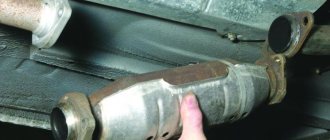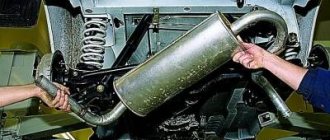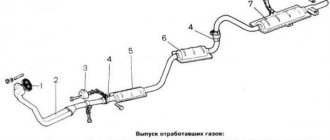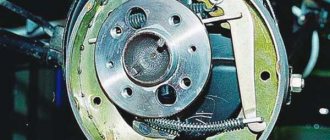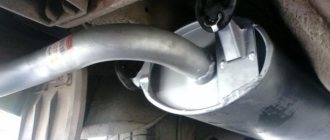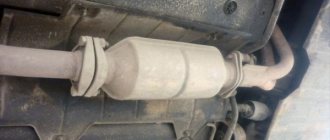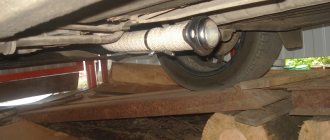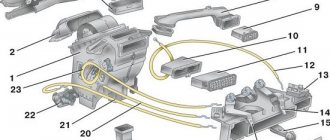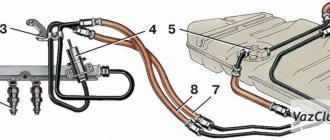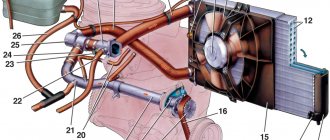Posted Jan 23, 2015 in Silencer, Tips and Instructions
Structurally, the exhaust gas removal system is almost a complete analogue of the system that was equipped with the predecessor of the VAZ 2109 family, the VAZ 2108. The only and main difference is the presence of a catalytic converter on the VAZ 2109.
However, it should be noted that the correct operation of the catalyst directly depends on the ratio of air and fuel supplied to the cylinders of the power unit. In this regard, only those models of the VAZ 2109 family that are equipped with a fuel mixture injection system are equipped with this element.
Schematically, the exhaust system of the “nine” consists of such elements as: a reception pipe, a catalyst, an additional muffler, and a main muffler. It should be noted that a lambda probe is installed in the exhaust pipe, which, based on the composition of the exhaust gases, controls the composition of the fuel mixture supplied to the engine cylinders.
The additional muffler is attached to the catalyst using a clamp. The main muffler is connected to the additional muffler in the same way. The assembled system is suspended due to rubber mounting hangers, which are fixed to 5 brackets located on the body.
Muffler device for VAZ 2108 and 2109
It should be noted right away that the mufflers of the VAZ 2108 and VAZ 2109 cars are practically no different from each other in design. The only difference is the dimensions: the exhaust pipe on the “nine” is 8 cm longer.
Muffler for VAZ 2109, body made of stainless steel
The muffler on VAZ 2109 and 2109 cars consists of two parts:
The main muffler body has the shape of an oval pipe and is made of alloy steel. The housing has a number of partitions that form resonator compartments. There are also two exhaust pipes (exhaust and inlet) and the main exhaust pipe. All these elements are connected using rolling. Spot welding is practically not used in such devices, so as not to reduce their corrosion resistance.
The muffler design for the VAZ 2109 is practically different from the muffler for the VAZ 2108
The resonator body is a round tube with an aluminum coating. Inside there is another pipe with holes, at the ends of which there are mounting flanges. With their help, the resonator is connected to the gas receiver of the car.
Catalyst
Replacing the catalyst on the “nine” is an impractical operation due to the cost. It is much cheaper to replace this element with a flame arrester. The exhaust system of the VAZ-2109 (injector, 8 valves) will not change its characteristics, and the exhaust will remain quiet. The only thing that will change is the toxicity of the gases. The exhaust will be more pungent. So what does it take? First, the catalyst itself is removed. To do this, you will again need a set of keys and an inspection hole. After unscrewing all the fasteners, the part is taken out. A flame arrester is installed in its place. A ready-made flame arrester is ideal in size. There are a lot of these sold in stores.
Main malfunctions of VAZ 2109 and 2108 mufflers
There are several typical muffler breakdowns that owners of VAZ 2109 and VAZ 2108 cars encounter:
The VAZ 2109 muffler burned out due to thermal corrosion
Old VAZ 2108 muffler resonator baffles removed
Muffler pipe of a VAZ 2109, broken at the suspension and knocking on the bottom of the car
Replacing the muffler on VAZ 2109 and 2108
Replacing a muffler on VAZ 2109 and VAZ 2108 cars always begins with the selection of the necessary tools and materials. Here's what we need to get started:
Sequencing
In order for the result of the work to please the car owner, it is advisable to act according to the following algorithm:
The clamp on the VAZ 2109 muffler can be unscrewed with only two keys
Before removal, the VAZ 2109 muffler clamp is unbent with pliers
To remove the VAZ 2109 muffler from the hangers, its body is lifted
Muffler removed from the hangers of a VAZ 2109 car
When installing the silencer, you should pay attention to the reliability of the connections and make sure that it is correctly secured under the bottom of the car.
Video: removing the muffler on a VAZ 2109
How to replace?
Based on the above, we can conclude that the best muffler repair is to replace it. This statement is also relevant for other parts of the VAZ-2109 exhaust system. The muffler is replaced with an inspection hole, a 13mm spanner and a socket of the same size. All actions are performed step by step:
- The car is driven into the inspection hole and put into gear.
- The main muffler is disconnected from the resonator. To do this you need to find a clamp. Use a spanner to tighten the fastening nut (to prevent twisting). At this time, the bolt is unscrewed with a ratchet.
- Afterwards, the fasteners are removed and the elements of the exhaust system are disconnected. The clamp is reusable, so we will put it back.
- Carefully remove the front part of the muffler from the rubber “cushion”, through which the part is attached to the body. Then the same operation is done with the front “pillows”.
- If the muffler is stuck to the resonator pipe, it can be rotated counterclockwise and back. This makes it easier to remove the muffler.
- The new element is installed in the reverse order.
Please note that rubber pads may be torn. It's better to buy a spare set. On the “nines” they are very flimsy. It is advisable to install pillows made of durable material (for example, polyurethane). This will not affect comfort (there will be no more vibrations), but the resource is at least twice as long.
Design Features
All domestic cars have approximately the same exhaust system. This greatly simplifies the issue of self-repair without the involvement of specialists.
The exhaust system (ES) includes several main components.
System element
Functions
A special probe is placed inside this pipe. This device studies the composition of exhaust gases, controls and analyzes the composition of the mixture that goes into the cylinder block
This is the very element of the system that allows you to minimize the harmfulness of gases escaping from the aircraft.
It is mounted to the catalyst using a special clamp. The purpose of the additional muffler is to absorb the main noise, so the sound at the exit from the pipe is insignificant
The same component that peeks out from under the rear bumper of your car. It connects to the additional muffler with a clamp
Main components and fasteners
The entire exhaust system of the VAZ 2109 car is in a suspended state and is held in place by the presence of rubber mounting hangers. The hangers, in turn, are screwed to the bottom of the car.
Popular faults
The exhaust system itself, together with the muffler, is quite reliable and durable due to its simple design.
Frankly speaking, there is nothing to break if you compare the aircraft with the engine, fuel, oil system, and so on.
The most common and unpleasant situation that can happen to an aircraft on a VAZ 2109 is a broken muffler. This is due to the quality of our roads, or rather to their absence.
Tuning
Those who want to change the exhaust sound to a sportier one can install a straight-through Stinger muffler. The exhaust system of the VAZ-2109 is also modified by installing a “Stinger” brand spider.
As a result, gases will freely leave the combustion chamber. But you need to understand that the exhaust sound will increase several times. Since there are no such labyrinths in a direct-flow muffler, all gases go directly into the atmosphere.
The car will sound sporty, but there is no need to talk about a significant increase in power. A more correct solution is to install such a muffler after upgrading the engine. You can start by installing a 16-valve head, then change the intake system, mount a turbine, and so on. There is no point in installing direct flow on a simple VAZ engine. The standard exhaust system already copes with the exhaust from a simple atmospheric engine. In the case of installing a turbine on a “nine”, such modification is simply necessary.
Repair methods
Often traveling along our “magnificent” roads, you now and then run over all kinds of bumps, potholes, and holes. If, after passing another similar obstacle, the car begins to make noticeable noise, which was not the case before, then the most likely outcome is a hole in the main muffler. The presence of a hole does not allow you to work calmly, quietly and efficiently as before.
The law of the Russian Federation states that it is prohibited to operate a car with a broken muffler. Therefore, the only correct solution would be to repair the unit.
There are two ways to repair the main muffler:
Replacing the main muffler
To remove the muffler, follow fairly simple step-by-step instructions.
When choosing a new main muffler, focus on the characteristics of the factory product. If you want to modify the rear of the car, simply install a decorative nozzle on a regular pipe. You should invent something with the modernization of the aircraft only if work is being carried out on the technical modification of the car - tuning.
Dismantling works
Replacing the resonator
To change the additional muffler, follow the instructions provided:
Changing the catalyst
Let’s say right away that failure of the catalyst on a VAZ 2109 is quite a rarity. But it will not be superfluous for anyone to understand the features of replacing this element.
When the engine is running, the catalyst heats up to 600 degrees Celsius, so it takes longer to cool down than a pair of mufflers. Make sure the element is cool before starting work.
How to make the muffler sound quieter
You can do all the work listed below with your own hands. So, how to make the exhaust quieter:
- install an additional resonator;
- replace the old resonator with a new one;
- replace the muffler with a new one.
If everything is clear with the third method, then the first two need additional clarification. Let's start with what a resonator is and what it is responsible for.
What is the function of the resonator?
The resonator as part of the exhaust structure dampens (dissipates) sound vibrations that arise as a result of the release of loud exhaust gases from the combustion chamber. Structurally, the resonator is a multicomponent device through which gas flows pass. In everyday life it is often called the “middle muffler”, since it is located precisely in the middle part of the exhaust system. Gases under pressure enter the resonator, lose some of their energy and move further with less momentum. Later, passing through a system of labyrinths in the jammer, they are further dispersed.
The sound volume is influenced by several parameters of the resonator: its size, shape and design. If the operation of this device is disrupted, the entire exhaust system suffers, and first of all the driver: he not only listens to loud sounds, but also breathes gases that penetrate into the car's interior. At the same time, the engine suffers and its service life decreases.
The performance of the resonator depends on three factors: the condition of the catalyst, which reduces the concentration of harmful substances in the exhaust gases, the diameter of the pipes and the cleanliness of the muffler itself. If the device operates stably, it means that gas passes freely through its cavities, but at the exit its energy is several times less than at the entrance. For foreign cars, exhaust system components are usually made of denser and heavier materials that are less susceptible to vibration. This also needs to be taken into account when assessing its operation and, most importantly, the “loudness” while the car is moving.
How to install a resonator
Above we wrote about how to reduce the exhaust sound - install an additional one or replace the old resonator with a new one. Here's what you need to do in the first case:
- cut out a fragment of the pipe that connects the main resonator and muffler;
- install and weld an additional resonator in the vacant space;
- Check the correct operation of the ignition and fuel supply system.
As an alternative to the standard resonator, you can choose a model with sound-absorbing filler. In such a device, the internal cavities are filled with basalt fiber or a material with similar characteristics. In addition to the main property - the ability to absorb sounds - the filler is durable and tolerates high temperatures well. The only drawback of such a device is the high price.
You can thoroughly study the exhaust system of your car, learn techniques on how to reduce exhaust volume on forums on the Internet, and even put them into practice - do it all yourself. However, it is better to entrust the solution to the problem to the specialists of the Muffler Master service.
You can sign up for diagnostics in St. Petersburg by calling the phone number listed on the website. The service hours by appointment are from 10:00 to 23:00 (for other clients - until 19:00). If you need advice on choosing a new exhaust system component, our specialists will help with this and organize the supply of the necessary spare parts. We know how to make your car move quietly and with maximum comfort for passengers!
Exhaust system of VAZ 2108, 2109, 21099 cars with carburetor engine
The exhaust system of carburetor engines of VAZ 2108, 2109, 21099 cars consists of three parts: a receiving pipe, an additional muffler and a main muffler. The parts of the system are connected to each other by means of flared pipe ends and metal conical sealing rings located between them, clamped with clamps. The system elements are attached to the engine exhaust manifold with a flat flange on the exhaust pipe, through a gasket and four studs with nuts.
Elements of the exhaust system of VAZ 2108, 2109, 21099 cars
The exhaust system is suspended from the body by brackets on rubber cushion rings (5 pieces). In the front part, the exhaust pipe is additionally secured with a bracket from the engine.
The exhaust pipe of the exhaust gas exhaust system consists of two pipes attached on one side to a flange, on the other to a gas receiver consisting of two stamped metal halves. The gas receiver, on the side of the additional muffler, ends with a metal intake pipe flared at one end. The gasket between the exhaust pipe flange and the engine exhaust manifold flange is made of asbestos reinforced with perforated steel tape.
An additional muffler (resonator) consists of a housing with a perforated pipe and partitions inside. The additional muffler pipes also have flared edges for connection to the exhaust pipe and the main muffler. The outside of the optional muffler can be treated with aluminum to improve corrosion resistance.
The main muffler also consists of a housing with perforated pipes and partitions inside. The housing can be made of stainless steel to prevent corrosion. Two pipes are attached to the muffler body: on one side, flared, for connection with an additional muffler, on the other side, straight, for exhaust gases.
Both mufflers do not have welding points and are assembled by rolling parts to prevent corrosion.
Diagram of the exhaust system of a carburetor engine of VAZ 2108, 2109, 21099 cars
Notes and additions
— On VAZ 21081 cars, the muffler exhaust pipe is single, not double, since the exhaust manifold of the 21081 engine has one hole.
— The exhaust system of the injection engine of VAZ 2108, 2109, 21099 cars is discussed on our website in the article: “Exhaust system of the injection engine of VAZ 2108, 2109, 21099 cars.”
Source
Device
In total, this system includes several elements. This:
- An exhaust manifold. This is the very first part through which gases pass after combustion. People call the collector a spider for its characteristic shape. This element is supplied to each of the four cylinders of the internal combustion engine. Then all these pipes are combined into two, and then into one single pipe. There are also sports manifolds with a 4-2-1 exhaust pattern. They are installed to increase power. As practice shows, gases move more freely along the path, but the driver still will not feel a significant increase in power.
- Reception pipe. It connects to the collector. There is a special probe inside this pipe. This is an oxygen sensor, or lambda probe. If we talk about the VAZ-2109 exhaust system (carburetor), there is no such sensor in the system. But on car injectors, a lambda probe is required. The slightest problems with it may be accompanied by a “Check Engine” lamp on the instrument panel. In fact, the exhaust pipe has the simplest device. There are no sound-reflecting partitions or special fillers. This is an ordinary hollow pipe in which a single sensor can be located.
- Catalyst. As in the previous case, this element is present only on injection versions. There is no catalyst on carburetor engines. What is this element needed for? Its main task is to reduce the concentration of harmful substances in exhaust gases. Passing through the catalyst honeycomb, harmful metals are converted into harmless oxides. Thanks to the use of this element, the machine began to comply with the environmental standard Euro-2 and higher. The catalyst is the most expensive element in the VAZ-2109 exhaust system (injector). Therefore, when it malfunctions, many install flame arresters or simply knock out the core and weld the walls, leaving the catalyst empty inside.
- Resonator. This element is present on both carburetor and injection versions. A resonator is installed behind the catalyst. What is his task? The resonator serves to absorb the main noise from the exhaust gases. Thanks to this element, the sound of gases becomes less. The resonator is designed simply. This is a metal case with a perforated pipe inside. Additionally, there may be a partition inside.
- Main muffler. The resonator can be called an auxiliary muffler, but the main sound energy is absorbed by the last muffler, located under the rear bumper. It enters the resonator and absorbs up to 90 percent of the sound. The structure of this element is somewhat more complicated. The basis here is also taken from perforated tubes, but there are several of them, as well as chambers. Usually these are three or four tubes and two chambers. Passing through this entire labyrinth, the gases lose their energy and exit without unnecessary sound.
Read also: Automatic transmission diagram Golf 3
The design of the exhaust system in the VAZ 21099
If a car engine is given the opportunity to “breathe” freely, i.e. create conditions for the unhindered release of exhaust gases, then, without a doubt, its efficiency and power will increase. But in this case, life in cities would become unbearable, and drivers would have to put in earplugs.
Exhaust systems are constantly being improved, they are assigned additional functions related to reducing toxicity and optimizing the fuel mixture. The VAZ 21099 is no exception - some, especially re-exported, cars of this model were already equipped with catalytic converters and λ-probes in the early 2000s. Why these innovations are needed - a little later, let's start the description with the design of the exhaust system on the carburetor VAZ 21099.
Exhaust system of carburetor VAZ 21099
In addition to the exhaust manifold installed on the cylinder head, it consists of three main elements (see figure below):
To attach parts to the body, there are hooks on the muffler and resonator, by which these parts are suspended from the bottom through rubber pads 5.
To ensure that the receiving pipe flange does not experience overloads when oscillating in motion, there is a receiving pipe bracket 1 attached to the block.
Between the flange and the manifold there is a sealing metal-asbestos gasket 2; connections of pipes whose ends are flared are made using special clamps 4 with metal rings:
Dual Exhaust Installation Steps
- First of all, you need to remove the old muffler.
- Afterwards, you should hang the right part of the new muffler on the right side of the car (previously placed on a lift), while using the existing cushions. In this case, the left part does not need to be fastened; you just need to connect the muffler to the resonator using a clamp and seals.
- Next, you need to connect the left part of the muffler to the main part through the pipes. In this case, it is necessary to take into account the location of the fastening rod, and it is also necessary to calculate the place where the holders in the form of brackets will be placed.
- It is necessary to use a drill to make two holes with a diameter of 1.5 mm in the spar. These holes can attach a holder, which is screwed with self-tapping screws.
- The completed operations allow you to move on to attaching the main left part. Fastening is carried out by inserting the muffler cushion directly into the bracket-shaped holder; the exhaust rod is also inserted into the cushion.
- The opposite side of the muffler is secured using O-ring clamps. This fastening should not be too tight.
- All the work done allows us to move on to the process of adjusting and establishing symmetry between the two exhaust pipe tips. Initially, loosely tightening the connections will allow the installation to be fine-tuned.
Muffler for VAZ 2108, 2109, 21099 cars
Let's consider the design and principle of operation of the exhaust system muffler of carburetor and injection engines of VAZ 2108, 2109, 21099 cars.
The muffler in the exhaust system is designed to reduce noise from exhaust gases escaping at high speed, pressure and flow fluctuations from the engine cylinders.
Location by car
The muffler (both main and additional) is located under the bottom of the car and is connected either to the intake pipe (carburetor engine) or to the catalytic converter (injection engine).
Muffler device
On VAZ 2108, 2109, 21099 vehicles, the exhaust gas system has a muffler: a main one and an additional one (resonator).
The main muffler is a metal (heat-resistant steel) oval-shaped body. Inside the muffler there are partitions that divide it into several resonator chambers and pipes with holes (inlet and outlet pipes, front perforated pipe). The connection of the muffler body elements is made without welding points, by rolling, to increase corrosion resistance. The connection between the main muffler and the additional muffler is made through the flared ends of their pipes, a metal conical sealing ring and a two-piece clamp.
The additional muffler (resonator) also has a metal body, cylindrical or oval. The body is treated with aluminum to prevent corrosion. Inside the housing there are partitions and a perforated pipe connecting the input and output of the resonator. The connection of the additional muffler to the exhaust pipe (carburetor engine) is similar to the connection to the main muffler. The connection to the catalytic converter (injection engine) is made through flat flanges at the ends of their pipes.
Design of the main and additional mufflers for the exhaust gas exhaust system of VAZ 2108, 2109, 21099 vehicles
The principle of operation of the muffler
The operation of the muffler is based on the expansion of gases entering the housing from its inner pipe. Here they repeatedly change direction, passing between the partitions, are divided into streams, and are slowed down by the perforated rough surfaces of the pipes. In the resonator chambers of the muffler, fluctuations in gas pressure are equalized when they are repeatedly reflected from the walls. The different volumes of the resonator chambers provide attenuation of noise of different frequencies. As a result, the energy of the exhaust gases decreases, they cool down, and the noise level at the outlet of the muffler is significantly reduced.
At the same time, the resistance to the flow of gases passing through the muffler is not too great, since otherwise the engine power will drop (backpressure effect). When tuning a car, a direct-flow exhaust is often installed in order to reduce the resistance to the passage of gases and slightly increase engine power.
Notes and additions
— When the car engine is running, at the moment the exhaust valves open, the exhaust gas pressure is 0.3-0.5 MPa, and their temperature is over 1000 degrees. Therefore, gases pass through the valves into the exhaust manifold at high speeds, which is accompanied by increased noise. In addition, when each exhaust valve opens, popping noises occur at a certain frequency, depending on the rotation speed of the engine crankshaft. All together creates a fairly high noise level, which is suppressed by the muffler.
Source
Damper installation
The damper is installed either before or after the muffler. The volume of the forward exhaust will be clearly reduced only when the damper is completely closed. Technological clearances of 3-5% remain for the passage of exhaust gases - so the engine does not stall. In this regard, engine power is significantly reduced due to blockage of the exhaust system.
the damper is made by hand
A damper is also used to switch from a direct-flow to a return-flow muffler and vice versa, if necessary. In this case, a new muffler is installed parallel to the old one, and the damper is mounted in front of them. This scheme is already used on some brands of cars from the factory.
mechanical adjustment of the damper is carried out on the move by the driver from the cab
You can drive a short distance with the throttle closed, but driving constantly is unacceptable for the engine.
the damper is installed in front of the muffler
